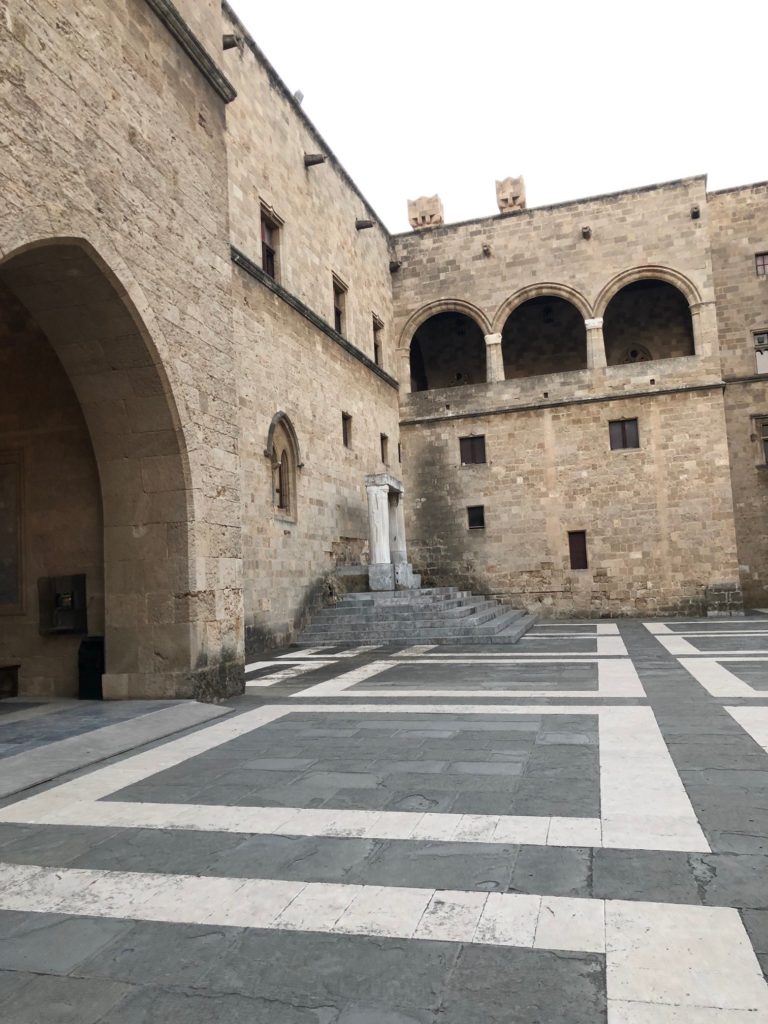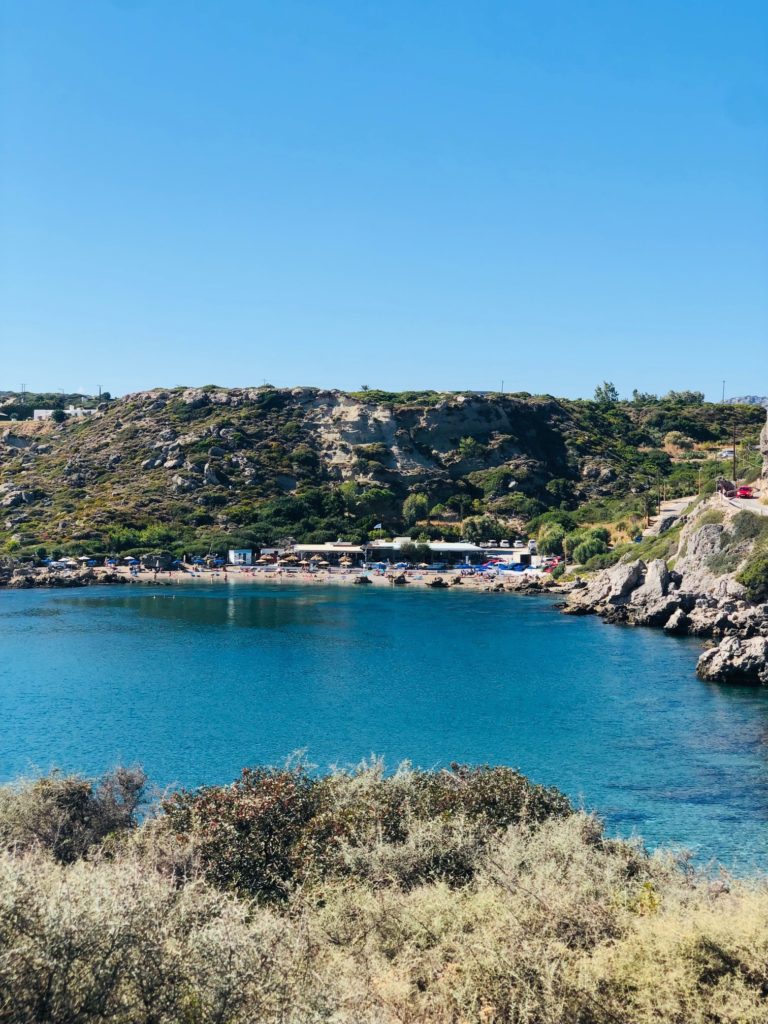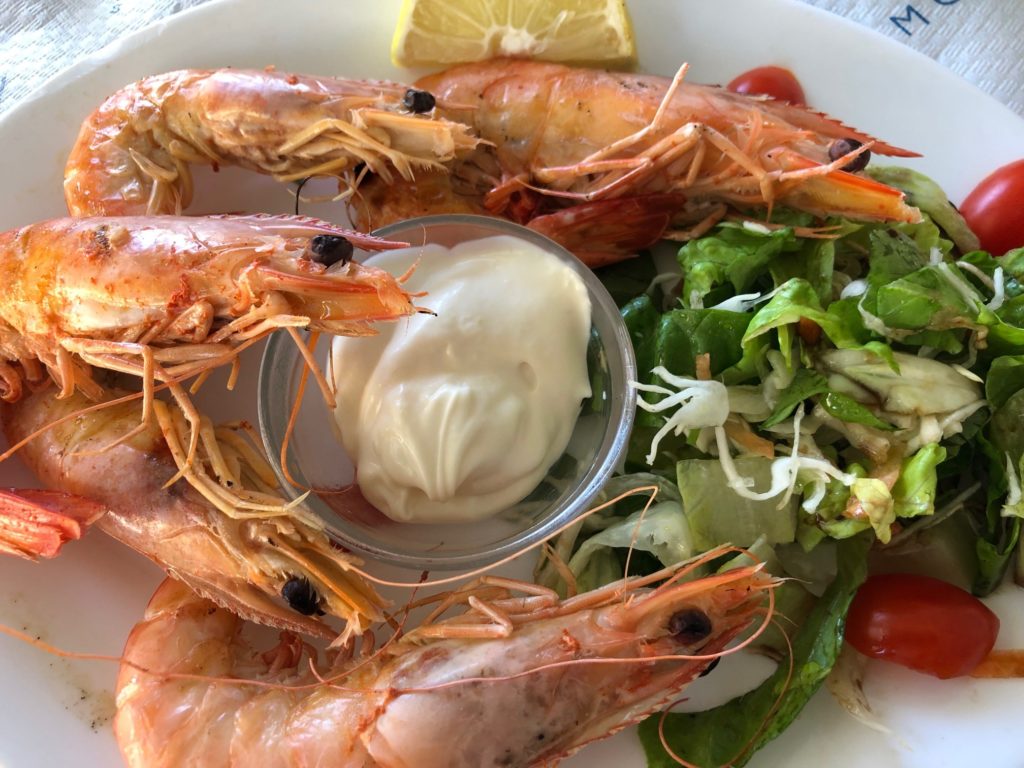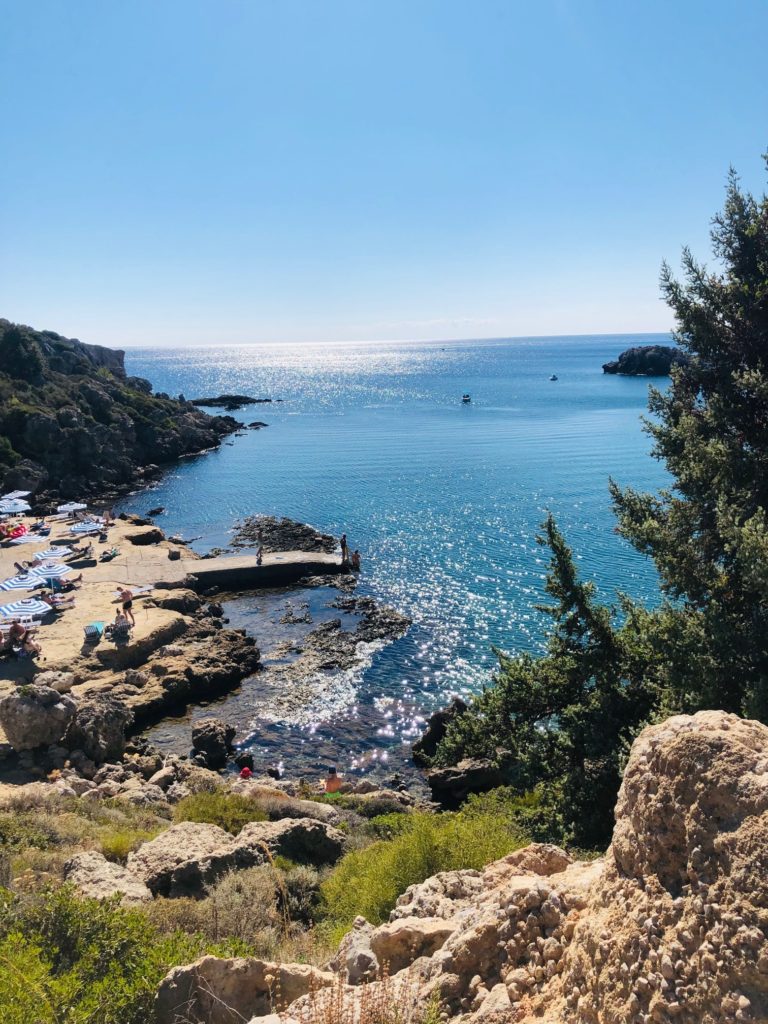After two whirlwind days in Athens, we are on our way to Rhodes. Known as the largest of the Dodecanese islands (Greek islands known for their medieval castles and Byzantine Churches) Rhodes is in the Aegean Sea, a recess in the Mediterranean Sea between Europe and Asia. Rhodos, as the locals call it, is a short hour’s flight from Athens but it’s my first time visiting, so the trip seems interminable

As the plane starts to land, I am glued to the window and can almost feel the drops of crystal blue water on my face. Yes, it’s that clear and that close. We go down the steps of the small plane, board a transport bus, and are driven, I am not kidding about this, 20 feet to the entrance of the terminal. It feels like a joke, but no one is laughing. The bus driver must be related to someone with influence to get this job. Inside, the small airport is laid back and slow, the few workers have that easy-going nonchalance about them, knowing that they own the beach after their shift is over.

The exit doors slide open, and I finally truly feel the fresh Mediterranean breeze on my face and that beachy pine-and-sand smell confirms I am on an island. On the taxi ride to the hotel, I am mesmerized by the houses, the makeshift roadside businesses, people going about their normal lives, a blur of familiar structures but foreign text on store fronts. Our taxi driver suddenly turned-tour-guide gives us all kinds of explanations about places to eat and visit but I halfway listen to her. Although a bit chilly in October, I concentrate on the people on uncrowded beaches, strolling along the pebbled sand. After much safety checks and protocol, Covid safe rules, we check into the hotel and begin to make ourselves comfortable in our home for the next five days. I open the drapes and discover the depth of the resort town that Rhodes is known for. From our balcony, I discover an unexpected sight: miles of blue sparkling water and right beyond, Turkey, a few miles away but clear enough to see.

There are many tales about the origin of the island’s name, but the most reliable is that it comes from the ancient Greek Rhódon (rose) which is why Rhodes is also called the island of roses. Rhodes is best known for its famous statue, The Colossus of Rhodes which was a statue of the Greek sun-God Helios, built in 280 BC. Considered one of the Seven Wonders of the Ancient World, it was erected to celebrate the successful defense of Rhodes against an attack by Demetrius I (also called Poliorcetes), a Greek Macedonian nobleman and military leader. The gigantic statue straddled the port and stood about 108 feet high (about as tall as the Statue of Liberty). It collapsed during the earthquake of 226. However, our very knowledgeable guide Nickolas, with a PhD in Archeology and 11 years’ experience in Greek digs, tells us it was probably not as tall as described or even located in the port’s entrance. Efforts to find the pieces have not been successful thus far and expensive plans to recreate it are not compelling. The entrance of the port now features statues of deer symbolizing the large deer population on the island. Nickolas is exuberant and entertaining. He tells us to ask him anything, his batteries have been charging for a year and a half of confinement.
Rhodes old town is a walled-in medieval fortress now classified by UNESCO. Palaces, ruins, and mosques abound, reflecting the many people who have ruled over the island from one era to another. Of course, as in everywhere in Greece, there are numerous temples to gods and goddesses, mostly Athena, lucky woman, and thousands of relics that exhale history and myth.



The old town’s main palace is the Palace of the Grand Master of the Knights, originally built as a fortress by the Knights of St. John during the Crusades and a great example of Gothic architecture in Greece. In 1856, the palace was destroyed by an accidental explosion and restored by the Italians in the early 20th century as a residence for Mussolini. As the imposing name would suggest, the building is a massive structure with room after room (I didn’t count but I assure you, there are many) adorned with statues, artifacts and gifts from foreign emperors and other prominent visitors. The primary attraction is the series of utterly impressive Roman mosaic floors transported and reconstructed from the island of Kos.
Next is a quick visit of The Archeological Museum, (you can buy a two-for-one ticket at the Palace),an ancient hospital displaying thousands of rescued treasures. Many of the statues are from the same era of the Venus de Milo, showcasing the silky lines of the Hellenistic period. We tour the mostly deserted rooms, it’s as if we have the museum all to ourselves, a real treat.

As we exit, we walk down the Street of the Knights, a long cobblestone road that crosses the old town and takes you to the hustle and bustle of the main merchant street. Never-ending shops full of statuettes, olive oil products, leather sandals, surprisingly intermingled by luxurious fur stores. The merchants are all happy to finally see tourists again but are in no way aggressive to lure you in, a refreshing feeling as you window shop. Restaurants, mostly empty, are a bit louder, the owners hawking the quality of their specialties, there is a lot of competition. Be aware that the shops close right before dinner time so if you want to shop for something, get it before it gets dark.



The next morning, we rent a car to see more of the island and happily end up in Anthony Queen’s Bay. Known as one of the most beautiful beaches in Rhodes, the bay is famous for its emerald tinted water surrounded by pine trees and lush vegetation. The actor fell in love with this bay when part of the movie Guns of Navarone was filmed in the area and he bought a portion of the land, hence the name. There is only one restaurant on the bay, so there is no debate for lunch. Fresh seafood abounds, the sun shines on the open bay in front of us, we understand why the actor loved it here.



We continue our road to the south and stop at Lindos, a breathtaking town on the island with the expected, but much welcomed, white-washed houses atop a hill. Another acropolis with a temple dedicated to, the one and only, Athena, is surrounded by water and probably one of the most spectacular sea views all around. The shops in towns are a maze of streets that are a bit hard to walk on but beautiful to see. Intricate patterns made from slippery stones can be hard to handle. Blue is the official color everywhere as if a soft cotton candy cloud is around you all the time.

Restaurants in Greece, and especially the ones we tried in Rhodes, like to serve food as sharing dishes. One plate after another with a specialty of the house comes out, taste after taste of squid, tzatziki, octopus, humus, warm homemade pita bread, and on and on. Mediterranean food heaven.
Two places well worth the mention in Rhodes, were Hatzikelis, marinated anchovies, lamb, incredible squid risotto among other great dishes, made with orzo instead of rice. The atmosphere is friendly and light, the staff looks like they are enjoying themselves and sharing dishes are constantly passed.

Nireas, hands down, is our best meal in Rhodes. To start, the setting was idyllic, an outside courtyard with strings of lights and cozy tables all around. The owner works the crowd, with his impeccable handle of the English language, and convenes with his guests in a genuine way. He is the ultimate host, engaging and funny. The food is a delight. The Tzatziki is presented as “made in heaven” and it is! The best Greek salad in town, the fresh fish, warm pita bread, the delicious grilled octopus. By the time the main course comes along, it feels like we have finished a whole dinner, but we make some room for it, nevertheless. The evening ends with a flaky and delicious baklava accompanied by heavenly vanilla ice cream. A pure delight, an address to remember.

Our time in Rhodes comes too quickly to an end. A long list of places to see and try are still in my notebook, ready for the next time. We say so long but not goodbye, we will come again!
